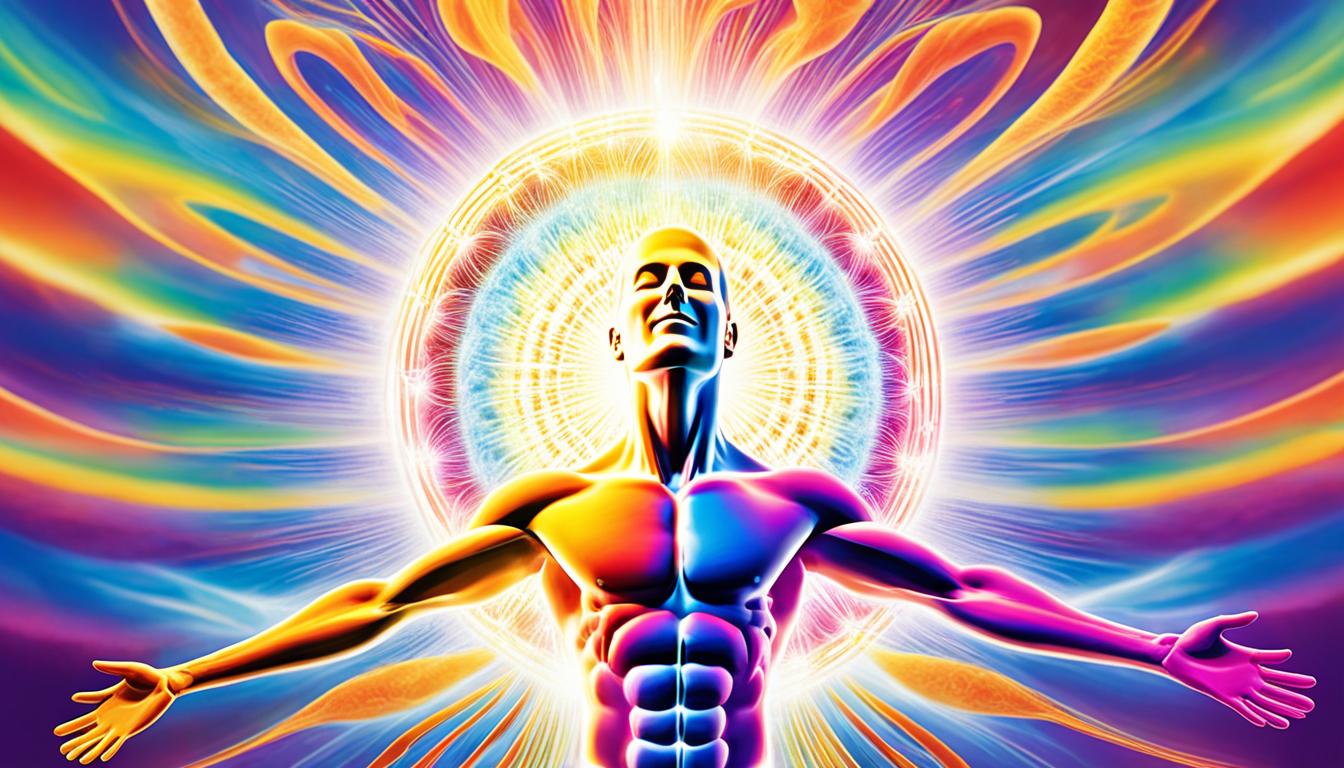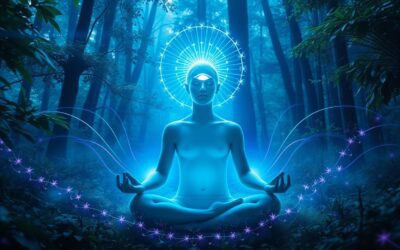Welcome to our exploration of energy healing and alternative therapies! In today’s hectic world, where stress and imbalance are all too common, many individuals are seeking holistic approaches to well-being and balance.
Energy healing therapies offer a natural and spiritual path towards self-care and healing. These practices, rooted in ancient wisdom and embraced in modern practice, embody a diverse range of techniques aimed at nurturing the body, mind, and spirit.
From Reiki to acupuncture, Qigong to Healing Touch, these complementary therapies tap into the body’s own natural healing abilities to promote overall well-being. Through the understanding and alignment of the body’s energy fields, individuals can achieve a state of harmony and balance, allowing for physical, emotional, and spiritual healing.
Energy healing, sometimes referred to as energy medicine or natural healing, encompasses a range of practices that work in harmony with the body’s energy systems.
By gently manipulating and balancing these energy fields, practitioners aim to remove blockages and promote the body’s inherent ability to heal itself. These therapies are often considered complementary to traditional medical treatments, providing a holistic approach to well-being.
Throughout this series, we will dive into the origins, principles, and benefits of different energy healing therapies. We will explore how these practices can enhance our overall well-being, bringing us closer to a state of balance and harmony.
Join us on this journey as we uncover the ancient wisdom and modern practices of energy healing and alternative therapies. Together, we can discover the power of these holistic approaches and cultivate a deeper connection between our body, mind, and spirit.
What Is Energy Healing?
Energy healing is a holistic practice that encompasses various techniques aimed at restoring the balance of the body’s energy fields. The core principle behind energy healing is that diseases and conditions are the result of disruptions to the body’s energy flow.
These practices, such as Reiki, acupuncture, Qigong, and Healing Touch, aim to remove blockages and promote the body’s natural self-healing capabilities. They consider emotional, physical, and spiritual imbalances as factors that can disturb one’s energetic harmony.
In energy healing, the body is viewed as a complex system of interconnected energies. When these energies are in balance, health and well-being are achieved.
However, disruptions in the body’s energy flow can lead to imbalances and health issues. By addressing these disruptions and restoring the proper energy flow, energy healing practices seek to improve overall health.
Emotional imbalances, such as stress, anxiety, and trauma, can create energetic blockages in the body. Energy healing techniques aim to release these blockages and restore emotional equilibrium.
Physical imbalances, such as pain, inflammation, and illness, are believed to be reflections of underlying disruptions in the body’s energy flow. Through techniques like acupuncture, energy healing aims to address these physical imbalances and promote healing.
Spiritual imbalances, such as a lack of purpose or disconnectedness, can also affect one’s energetic harmony. Energy healing practices offer a path to restore spiritual well-being by reconnecting individuals with their innate spirituality and aligning their energy with higher consciousness.
Each energy healing modality brings its own unique approach and techniques. Reiki, for example, involves the transfer of universal life energy through the gentle touch of the practitioner’s hands.
Acupuncture works by stimulating specific points along energy pathways called meridians. Qigong combines movement, breathing exercises, and meditation to cultivate and balance energy. Healing Touch employs a range of techniques, including energy clearing and chakra balancing, to promote healing and well-being.
Overall, energy healing provides a holistic approach to improve health and well-being by addressing disruptions in the body’s energy flow. By tapping into the body’s natural self-healing capabilities, energy healing practices aim to restore balance, promote healing, and enhance overall quality of life.
| Energy Healing Techniques | Description |
|---|---|
| Reiki | Reiki involves the transfer of universal life energy through gentle touch or distance healing. |
| Acupuncture | Acupuncture works by stimulating specific points along energy pathways called meridians to restore balance. |
| Qigong | Qigong combines movement, breathing exercises, and meditation to cultivate and balance energy. |
| Healing Touch | Healing Touch employs various techniques, such as energy clearing and chakra balancing, to promote healing and well-being. |

Image:
The Origins of Energy Healing Therapies
Energy healing therapies have ancient beginnings, with traditions spanning across cultures and centuries. These healing practices have been woven into the rich tapestry of our multicultural heritage, each contributing to our understanding of the body’s energy flow and its impact on our overall well-being.
In ancient Egypt, healing temples were revered as sacred spaces where energy healing rituals took place. These rituals often involved the use of crystals, which were believed to amplify and direct spiritual energy for healing purposes.
In China, ancient arts like acupuncture and Qigong emerged as methods of manipulating and balancing the body’s energy. Acupuncture, using the insertion of thin needles along specific points on the body’s meridians, aimed to restore balance and free energy flow.
Qigong, on the other hand, focused on gentle movements, breathwork, and meditation to cultivate and harmonize energy within the body. Meanwhile, in India, the practices of yoga and Ayurveda embraced the concept of prana, or life energy.
Yoga, with its physical postures (asanas) and breath control (pranayama), aimed to harmonize the body, mind, and spirit, promoting balance and free flow of energy. Ayurveda, the ancient Indian system of medicine, incorporated various techniques, such as massage, herbal remedies, and dietary guidelines, to maintain the balance of energy within the body.
As these ancient arts flourished, their influence extended beyond their country of origin. In the late 19th and early 20th centuries, the Western world began to show interest in these alternative healing therapies. This interest led to the development and spread of practices like Reiki, a Japanese form of energy healing that channels universal life energy for balance and healing.
Today, energy healing therapies continue to thrive, combining ancient wisdom with modern practice. These therapies reflect the profound interconnectedness of our body, mind, and spirit, and serve as a testament to the enduring power of holistic approaches in our quest for well-being.
Ancient Arts of Energy Healing
Let’s take a closer look at some of the ancient arts that have contributed to energy healing and continue to shape its diverse landscape:
| Ancient Art | Origin | Main Focus |
|---|---|---|
| Acupuncture | China | Manipulating energy flow through meridians using thin needles |
| Qigong | China | Harmonizing energy through gentle movements, breathwork, and meditation |
| Yoga | India | Uniting body, mind, and spirit through physical postures and breath control |
| Ayurveda | India | Preserving balance through various techniques, including massage and herbal remedies |
| Reiki | Japan | Channeling universal life energy through hands-on healing |
Understanding the Body’s Energy Fields
When delving into the world of energy healing, it’s crucial to grasp the concept of the body’s energy fields. These fields, often referred to as auras or chakras, represent different aspects of our physical and emotional well-being. Chakras are believed to be the seven main energy centers in the body, with each corresponding to specific organs and governing various bodily functions.
Chakras play a vital role in maintaining the balance and free flow of energy throughout the body. Here are the seven main chakras:
- Root Chakra: Located at the base of the spine, it represents stability, grounding, and our connection to the physical world.
- Sacral Chakra: Situated in the lower abdomen, it is associated with creativity, pleasure, and emotional well-being.
- Solar Plexus Chakra: Found in the upper abdomen, it relates to personal power, self-confidence, and transformation.
- Heart Chakra: Located in the center of the chest, it is the seat of love, compassion, and emotional balance.
- Throat Chakra: Positioned in the throat area, it governs communication, self-expression, and authenticity.
- Third Eye Chakra: Situated between the eyebrows, it represents intuition, wisdom, and spiritual insight.
- Crown Chakra: Located at the top of the head, it connects us to higher consciousness, universal energy, and spiritual well-being.
When these chakras are balanced, energy can flow freely, leading to a state of harmony and health. However, blocked or misaligned chakras can disrupt the energy flow, resulting in physical or emotional distress.
In addition to chakras, the aura, an electromagnetic field surrounding the body, reflects the energy produced by the chakras and can provide insights into emotional and spiritual well-being.
Understanding the body’s energy fields, including auras and chakras, is essential in energy healing practices as it allows individuals to identify and address any imbalances to promote overall well-being.

Reiki: The Universal Life Energy
Reiki is a renowned energy healing therapy that utilizes the universal life energy to promote well-being and balance. Known for its gentle touch and non-invasive approach,
Reiki involves the channeling of life force energy from the practitioner to the patient through specific hand positions. This high-energy interaction aims to balance the body’s energy and catalyze the natural healing process.
Central to Reiki is the belief that each individual possesses an unseen life force energy within them. By increasing the energy’s vibrancy and flow, Reiki practitioners aim to enhance physical health, emotional well-being, and mental clarity.
The attunement stages undergone by practitioners refine their skills in channeling and balancing the energy, enabling them to actively participate in the healing process. Through Reiki sessions, individuals can experience a profound connection between their body, mind, and spirit.
This holistic approach encourages the alignment of energy fields, creating a harmonious environment for self-healing and restoration. The gentle touch of Reiki and its emphasis on balancing energy make it a popular choice for those seeking non-invasive and nurturing healing techniques.
Reiki’s ability to promote relaxation, alleviate stress, and enhance overall wellness has contributed to its widespread popularity. Many individuals find that Reiki sessions result in improved physical health, emotional stability, and mental clarity.
Benefits of Reiki:
- Stress reduction and relaxation
- Pain management
- Improved sleep quality
- Enhanced emotional well-being
- Boosted immune system
- Increased energy levels
- Heightened self-awareness
Reiki’s universal life energy provides a gentle and nurturing approach to healing, fostering a deeper connection between the body, mind, and spirit. Whether used as a standalone therapy or in conjunction with other healing modalities, Reiki offers a holistic path towards well-being and balance.

| Stage | Description |
|---|---|
| 1 | Learning and understanding Reiki principles |
| 2 | Receiving attunements to open energy channels |
| 3 | Practicing hand positions for energy channeling |
| 4 | Mastering advanced Reiki techniques |
Acupuncture: Balancing the Body’s Energy Channels
Acupuncture, a cornerstone of traditional Chinese medicine, is a time-honored practice that aims to restore the balance of the body’s energy flow. This holistic approach involves the skillful insertion of thin needles into specific points along energy pathways known as meridians.
By stimulating these carefully selected points, skilled acupuncturists can help to clear disruptions and restore harmony within the body’s energy system. Acupuncture not only addresses physical symptoms but also considers the interconnectedness of the body, mind, and spirit, making it a truly holistic healing practice.
Acupuncture is more than just needlework; it is an art steeped in philosophy and rooted in ancient wisdom. Traditional Chinese medicine recognizes the significance of energy flow and its impact on overall health and well-being. By restoring balance to the body’s energy channels, acupuncture helps to promote optimal functioning and vitality.
Acupuncture has been widely used for pain management, as it can alleviate discomfort associated with various conditions. Additionally, this ancient therapy has demonstrated effectiveness in addressing other health concerns, such as anxiety, migraines, and nausea.
To further enhance the effectiveness of acupuncture, complementary techniques like cupping and moxibustion may be used. Cupping involves the application of suction cups to stimulate blood flow and release tension, while moxibustion involves the use of heat to promote healing.
Ultimately, acupuncture embodies the philosophy of traditional Chinese medicine, recognizing the importance of energy flow and its profound impact on well-being. By restoring balance to the body’s energy channels, acupuncture offers a natural and holistic approach to healing and promoting overall health.

The Benefits of Acupuncture:
- Effective for pain management
- Alleviates anxiety and aids in stress reduction
- Reduces the frequency and intensity of migraines
- Helps relieve nausea and digestive discomfort
- Promotes overall physical and emotional well-being
Conclusion
Energy healing and alternative therapies offer holistic approaches to well-being and balance. These practices, rooted in ancient wisdom and embraced in modern practice, focus on balancing the body’s energy fields and promoting overall health.
From Reiki to acupuncture, each technique has its own unique method but shares the common goal of recalibrating the body’s energy.
By delving into the world of energy healing and embracing these alternative therapies, individuals can tap into their own natural healing abilities and strengthen the connection between their body, mind, and spirit.
These ancient techniques have stood the test of time and continue to provide effective means of achieving holistic well-being in the fast-paced modern world. Whether it’s the gentle touch of Reiki, the precise needlework of acupuncture, or the focused movements of Qigong and Healing Touch, energy healing offers a pathway to balance and harmony.
By acknowledging the body’s energy fields and the profound connection between the body, mind, and spirit, we can embark on a journey of self-discovery and self-healing.
Incorporating energy healing and alternative therapies into our lives can not only improve our physical health but also enhance our emotional and mental well-being. The ancient wisdom and modern practice of these holistic approaches allow us to nurture our inner selves and achieve a state of balance and well-being.









